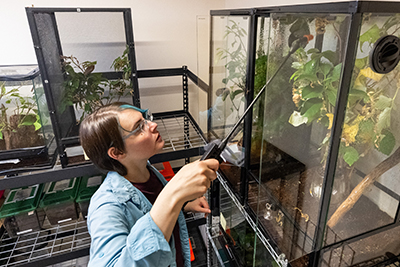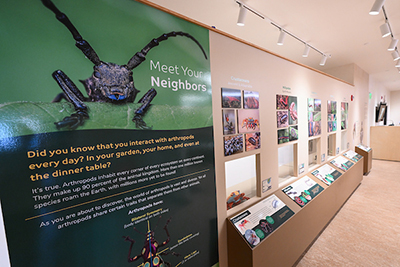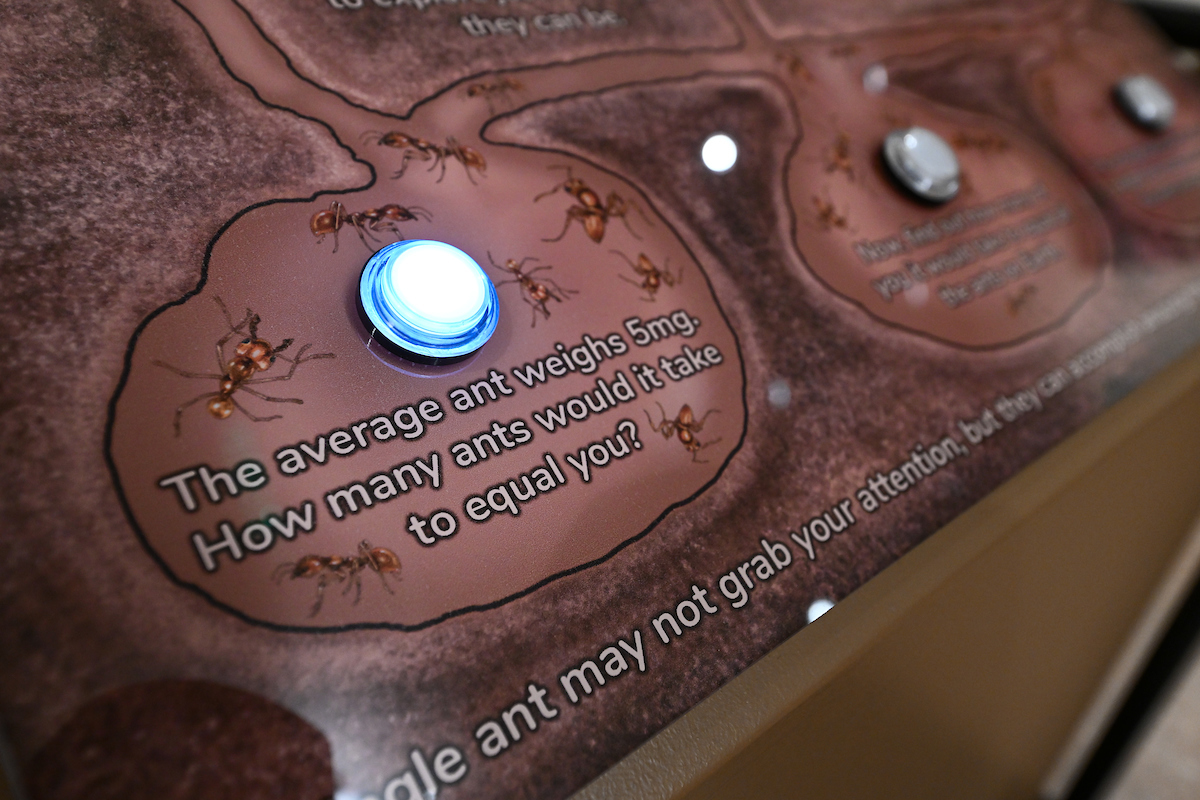Bugs in a Rug: UM and New Missoula Butterfly House Share Close Connection
Jen and Glenn Marangelo worked closely with UM faculty on the development of the new Missoula Butterfly House & Insectarium.
By Raequel Roberts, UM News Service
MISSOULA – When you’re the executive director of a live zoo with exhibits starring giant African millepedes and blue death feigning beetles, your expense receipts look as exotic as your star attraction – a Chilean rosehair tarantula named Rosie.
There are the raspberry leaves gathered by busy leafcutter ants and devoured by the Australian walking sticks, for starters. Then there are the costs of keeping hundreds of decidedly short-lived butterflies in flight.
“Our third-biggest cost right after utilities and personnel is actually butterfly pupae,” said Jen Marangelo, founder of the Missoula Butterfly House & Insectarium, which opens to the public Dec. 6. “At any one time we’ll have 500 free-flying butterflies here, and that means buying 250 pupae a week. They are expensive.”
Marangelo is standing in the butterfly greenhouse, a key feature of the new Gerald W. Marks Exploration Center at the Missoula County Fairgrounds.
Under construction for three years, the insectarium includes interactive learning stations – get on a scale to learn how many ants it takes to equal your weight – a beehive replete with an exterior exit hole for residents to gather nectar in nearby neighborhoods and a nook for the youngest nature explorers to learn all there is to know about Madagascar hissing cockroaches.
“There is such a diversity of insects in the world, and if you pay attention to them, you can’t help but be curious and in awe of their beauty and how they make their living,” Marangelo said. “If you have any curiosity at all, you can’t help but be engaged.”

Miriam Bayer, the Butterfly House’s lead animal keeper, tends to insects housed at UM during construction.
The idea to bring an insectarium to Missoula came to Marangelo while running a lab at the University of Montana in 2003. She was working for Regents Professor Doug Emlen, who’s garnered international renown for research in animal weaponry – most notably the significant horns sprouted by male scarab beetles.
“I really didn’t know much about bugs before I started working for Doug, and I was so lucky to learn from him,” Marangelo said of her seven years working for Emlen. “We would get a lot of requests from teachers to bring bugs into schools or take kids out into the school yard to look for bugs, and I learned really early on that this is a wonderful tool for teaching kids.
“Animals of any kind, actually, are wonderful teaching ambassadors,” she added, “but bugs in particular are so diverse that any concept you wanted to teach you could find a bug model.”
A trip to a butterfly house in Seattle was the ultimate spark for Marangelo’s decision to start something similar in Missoula.
“I was just blown away from the experience and could see everyone else was as well,” she said. “I realized butterflies are a great way to get people interested in insects. As we say in the industry: Butterflies are the gateway bugs to other bugs.”
Knowing nothing about running a zoo and little about the bug business or nonprofit administration, Marangelo enrolled in the Masters of Interdisciplinary Studies program at UM. The program allowed her to tailor her studies, and when completed she and husband, Glenn Marangelo, a veteran of nonprofit development work, decided it was time to launch the insectarium. Fundraising and forming a board ensued.
Their first facility opened downtown in 2015 and remained there four years until their lease expired. Without a permanent building, some of the museum’s insects went to live in Emlen’s lab, while others, along with staff, went to temporary offices at the Montana Natural History Center.
“The bugs in Doug’s lab must be permitted by the United States Department of Agriculture, because they could at some point in their lifespan damage crops. Keeping them requires lots of conditions,” Marangelo said. “The ones we took to the natural history center didn’t need permits.”
That includes Rosie, the centipede collection and roaches.
Marangelo describes their time at the MNHC as a “wonderful partnership” but not without an occasional hiccup. Like when a vinegaroon, also called whip scorpion, got loose.
“Their defense is to shoot acetic acid – vinegar – out their rear,” Marangelo said. “When it got loose, we tore the office apart. I emailed the whole staff and told them not to be frightened. It’s funny, but everyone dropped what they were doing and found it very quickly.“
“It looks like an alien,” recalled MNHC Executive Director Thurston Elfstrom with a chuckle when talking about the escapee. “We cornered it in the elevator and waited for the experts to come.”

The new facility features teaching exhibits for children and adults.
Finding a new home and raising the capital to pay for a new facility – with a pandemic thrown in for good measure – made for plenty of anxious moments for the Marangelos, their staff and board.
With support from former board member Bryce Christiaens, weed district manager for the Missoula County Department of Ecology & Extension, a conversation began in 2018 about incorporating the proposed butterfly house with the county’s new extension building on the fairgrounds.
“Bryce knew about this goal to build a bigger building as an education center and bring in other partners, so we said ‘Let’s do this,’ and we were invited into this beautiful building and given a home,” Marangelo said. “We would never be able to be on the fairgrounds without being in partnership with the county and this building.”
In addition to playing host to the insectarium’s bugs during construction, Emlen has been its champion: serving on the board, making calls to donors when needed and being a keynote speaker at the zoo’s Bugs and Brews lecture series. Larry Gianchetta, former dean of UM’s College of Business; Shawn Clouse, a professor in the College of Business; and Dale Woolhiser, a UM alum; also lent their expertise to fundraising.
Emlen said the museum will be a big enough attraction to “pull people off the interstate” and is the perfect example of the symbiotic relationship between UM and the community.
But it serves a deeper role as well.
“In the current state of our society, science and scientists are increasingly less trusted and that worries me,” Emlen said. “Science is a wonderful and clear way to process much of what happens in our world.
“This new facility can remind people of the excitement that comes from the natural world – from these amazing insects and butterflies,” he added. “It’s through that awe and wonder that we can actually begin to find solutions to some of the problems that face us.”
Marangelo, a consummate promoter of all things with six legs, encourages Missoulians of every age to participate in the museum’s diverse programming, but to also venture out and experience the many insects that thrive in Montana.
“You don’t have to go to the tropics,” she said. “Go out in your backyard.”

Visitors are invited to step on a scale to learn how many ants it would take to equal their weight.
###
Contact: Jen Marangelo, executive director, Missoula Butterfly House & Insectarium, 406-317-1211, jen@missoulabutterflyhouse.org.; Dave Kuntz, UM director of strategic communications, 406-243-5659, dave.kuntz@umontana.edu.